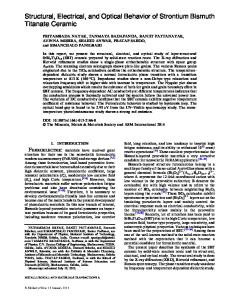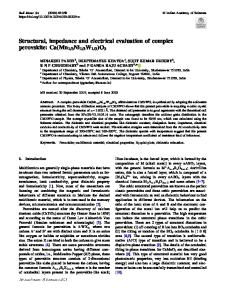Structural, optical and electrical properties of multiferroic BiFe 1-x Ni x O 3 ceramic
- PDF / 1,365,122 Bytes
- 6 Pages / 595.276 x 790.866 pts Page_size
- 15 Downloads / 299 Views
RESEARCH
Structural, optical and electrical properties of multiferroic BiFe1-xNixO3 ceramic S. S. Arafat 1,2
&
S. Ibrahim 3 & Huda Saad Al fannakh 1
Received: 3 January 2019 / Revised: 31 July 2019 / Accepted: 9 September 2019 # The Author(s) 2019
Abstract BiFe1−xNixO3 (x = 0.7, 0.8 and 0.9) polycrystalline ceramics are synthesized by a solid-state reaction, and their structural, absorption, leakage current and electrical properties are investigated. The X-ray diffraction measurements show that the lattice parameter values increase with increasing the substitution of Ni2+ ions for Fe3+ ions. The optical absorption spectra indicate that the band gap energy increases with increasing Ni2+ ions. Leakage currents are much decreased by about three orders of magnitude with increasing Ni ions. The J-E hysteresis was also investigated. Both real and imaginary dielectric constants are investigated as a function of both frequency and temperature. The room temperature dielectric measurement with a wide frequency range of 1 KHz–1 MHz reveals that the real and imaginary dielectric constants are decreased with increasing frequency of BiFe1−xNixO3 (x = 0.7, 0.8, 0.9) ceramics. The real and imaginary dielectric constants are found to be increased with temperature. The temperature dependence of ε′ and ε″ exhibits an anomaly which shifted to lower temperature with increasing Ni2+. The anomaly indicates the possible existence of spin-glass states with Ni2+ ion substitution in places of Fe3+ ions. Keywords Perovskite-like type structure . X-ray diffraction . Absorption spectra . Leakage current . Spin-glass state
Introduction In multiferroic system, a coupling of at least two or all three of antiferroelectricity, antiferromagnetism and ferroelectricity characteristic are observed in the same phase [1–3]. The existence of both ferroelectric, ferromagnetism and elasticity in such a system will provide more degree of freedom in the field of new functional sensors and actuators [1, 4, 5]. BiFeO3 represents one of such set of perovskite multiferroics family which has a ferroelectricity phase with cure temperature (Tc) that is around 820–850 °C [6, 7] and has an antiferromagnetic transition (TN) around 370–380 °C [6, 8]. The leakage current represents the main problem for such material, this is due to its
* S. S. Arafat [email protected]; [email protected] 1
Department of Physics, College of Science, King Faisal University, Al-Ahsa, Saudi Arabia
2
Department of Physics, College of Science, Fayoum University, Faiyum, Egypt
3
Department of Physics, College of Science, Cairo University, Giza, Egypt
low resistivity which is reflected as its instability [9]. The coexistence of both vacancies and Fe2+ ions represents the main source of leakage current [10–14]. Several attempts were carried out to overcome such problems using doping techniques. This was done by substituting part of Bi+3 with dope ions at the side A of BiFeO3 ceramic structure [15–18] or with substituting another type of dope ions (Nb+5, Mn+4, Ti+4 or Cr+3) at si
Data Loading...










